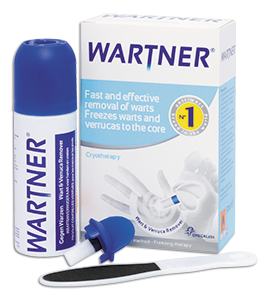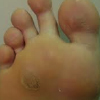Cryosurgery dates back to the 19th century where it was used for pain control and cancerous lesion removal 1.
In those days cryotherapy used liquid air 2 or carbon dioxide 3.Today, we use liquid nitrogen or over the counter (OTC) mixtures like dimethyl ether propane (DMEP) or dimethyl ether butane.
One of the initial methods of applying cryotherapy to skin lesions was cotton buds. Later this was replaced with gas sprays or cryo-probes that allow greater contact of the mixture to the skin lesion. Today, doctors have all these options available to them.
Cryotherapy is mainly used to remove skin lesions/ growths: warts, skin tags or solar keratosis.
Cryotherapy is often the doctors’ method of choice.
There are other wart removal treatments available, like chemical treatments, cautery or laser surgery but these treatment options can be extremely uncomfortable and can damage the surrounding tissue.
It is less invasive, has a low risk of scarring, and requires less patient compliance.
Patients prefer to use cryotherapy as it is cost effective, convenient and requires fewer treatments.
 Cryotherapy causes tissue destruction which aids in removal of skin lesions. Tissue destruction usually takes place around -50 degrees Celsius but the greater the temperature; the greater the tissue destruction.
Cryotherapy causes tissue destruction which aids in removal of skin lesions. Tissue destruction usually takes place around -50 degrees Celsius but the greater the temperature; the greater the tissue destruction.
Liquid nitrogen reaches the lowest temperature on the market: a frightening -196 degrees Celsius. Wartner; containing Dimethyl Ether Propane reaches a temperature of -57 degrees Celsius. Although there is a large difference in this temperature, Wartner is effectively able to remove warts.
Wartner is the coldest OTC product on the South African market and is able to reach this temperature after a minimal 20 seconds. This gives Wartner the best cryogenic properties on the market and the most optimum treatment time.
Wartner enables you to use the Doctors Preferred Method but at the comfort of your own home.
References:
- W, Basco. MT, Aruny. JE, Cheng. SWK Cheng, Sumpio. BE, Cryosurgery: A review. Int J Angiol 2007;16 (1):1-6.
- White AC. Liquid air: Its application in medicine and surgery.Med Rec. 1899;56: 109–12.
- Pusey W. The use of carbon dioxide in the treatment of nevi and other lesions of the skin.JAMA. 1907;49:1354–6.






